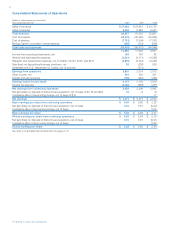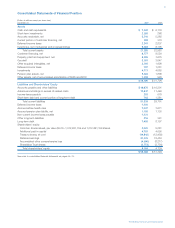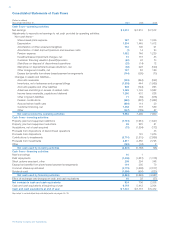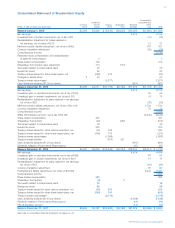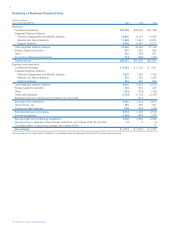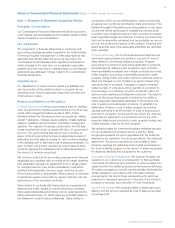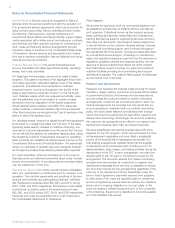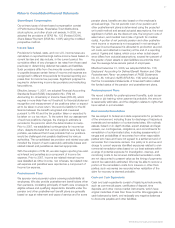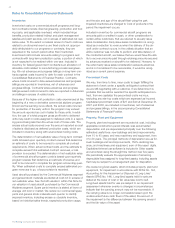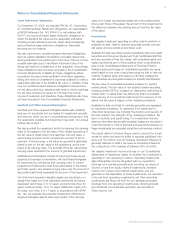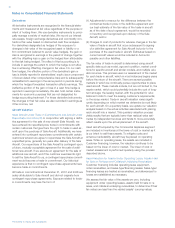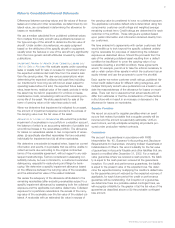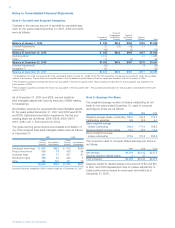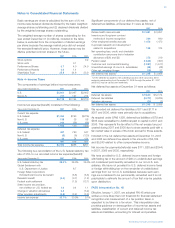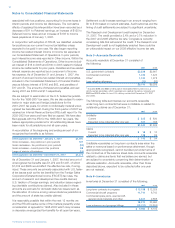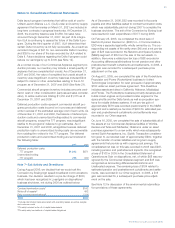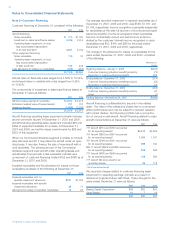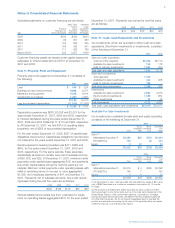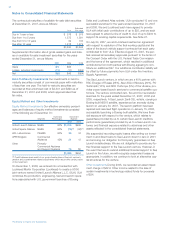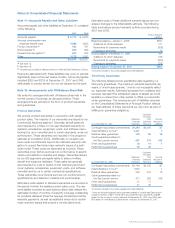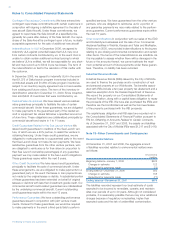Boeing 2007 Annual Report Download - page 53
Download and view the complete annual report
Please find page 53 of the 2007 Boeing annual report below. You can navigate through the pages in the report by either clicking on the pages listed below, or by using the keyword search tool below to find specific information within the annual report.50
Notes to Consolidated Financial Statements
Derivatives
All derivative instruments are recognized in the financial state-
ments and measured at fair value regardless of the purpose or
intent of holding them. We use derivative instruments to princi-
pally manage a variety of market risks. We record our interest
rate swaps, foreign exchange derivatives and commodity con-
tracts at fair value based on discounted cash flow analyses.
For derivatives designated as hedges of the exposure to
changes in fair value of the recognized asset or liability or a
firm commitment (referred to as fair value hedges), the gain or
loss is recognized in earnings in the period of change together
with the offsetting loss or gain on the hedged item attributable
to the risk being hedged. The effect of that accounting is to
include in earnings the extent to which the hedge is not effec-
tive in achieving offsetting changes in fair value. For our cash
flow hedges, the effective portion of the derivative’s gain or
loss is initially reported in shareholders’ equity (as a component
of Accumulated other comprehensive loss) and is subsequently
reclassified into earnings in the same period or periods during
which the hedged forecasted transaction affects earnings. The
ineffective portion of the gain or loss of a cash flow hedge is
reported in earnings immediately. We also hold certain instru-
ments for economic purposes that are not designated for
hedge accounting treatment. For these derivative instruments,
the changes in their fair value are also recorded in earnings as
Other income, net.
Aircraft Valuation
Used Aircraft Under Trade-in Commitments and Aircraft Under
Repurchase Commitments In conjunction with signing a defini-
tive agreement for the sale of new aircraft (Sale Aircraft), we
have entered into specified-price trade-in commitments with
certain customers that give them the right to trade in used air-
craft upon the purchase of Sale Aircraft. Additionally, we have
entered into contingent repurchase commitments with certain
customers wherein we agree to repurchase the Sale Aircraft at
a specified price, generally ten years after delivery of the Sale
Aircraft. Our repurchase of the Sale Aircraft is contingent upon
a future, mutually acceptable agreement for the sale of addi-
tional new aircraft. If we execute an agreement for the sale of
additional new aircraft, and if the customer exercises its right
to sell the Sale Aircraft to us, a contingent repurchase commit-
ment would become a trade-in commitment. Our historical
experience is that no contingent repurchase agreements have
become trade-in commitments.
All trade-in commitments at December 31, 2007 and 2006 are
solely attributable to Sale Aircraft and did not originate from
contingent repurchase agreements. Exposure related to trade-
in commitments may take the form of:
(1) Adjustments to revenue for the difference between the
contractual trade-in price in the definitive agreement and
our best estimate of the fair value of the trade-in aircraft
as of the date of such agreement, would be recorded
in Inventory and recognized upon delivery of the Sale
Aircraft, and/or
(2) Charges to cost of products for adverse changes in the fair
value of trade-in aircraft that occur subsequent to signing
of a definitive agreement for Sale Aircraft but prior to the
purchase of the used trade-in aircraft. Estimates based on
current aircraft values would be included in Accounts
payable and other liabilities.
The fair value of trade-in aircraft is determined using aircraft
specific data such as model, age and condition, market condi-
tions for specific aircraft and similar models, and multiple valu-
ation sources. This process uses our assessment of the market
for each trade-in aircraft, which in most instances begins years
before the return of the aircraft. There are several possible
markets in which we continually pursue opportunities to place
used aircraft. These markets include, but are not limited to, the
resale market, which could potentially include the cost of long-
term storage; the leasing market, with the potential for refur-
bishment costs to meet the leasing customer’s requirements;
or the scrap market. Trade-in aircraft valuation varies signifi-
cantly depending on which market we determine is most likely
for each aircraft. On a quarterly basis, we update our valuation
analysis based on the actual activities associated with placing
each aircraft into a market. This quarterly valuation process
yields results that are typically lower than residual value esti-
mates by independent sources and tends to more accurately
reflect results upon the actual placement of the aircraft.
Used aircraft acquired by the Commercial Airplanes segment
are included in Inventories at the lower of cost or market as it
is our intent to sell these assets. To mitigate costs and
enhance marketability, aircraft may be placed on operating
lease. While on operating lease, the assets are included in
Customer financing, however, the valuation continues to be
based on the lower of cost or market. The lower of cost or
market assessment is performed quarterly using the process
described above.
Asset Valuation for Assets Under Operating Lease, Assets Held
for Sale or Re-lease and Collateral Underlying Receivables
Customer financing includes operating lease equipment,
notes receivables, and sales-type/financing leases. Sales-type/
financing leases are treated as receivables, and allowances for
losses are established as necessary.
We assess the fair value of the assets we own, including
equipment under operating leases, assets held for sale or re-
lease, and collateral underlying receivables, to determine if their
fair values are less than the related assets’ carrying values.
The Boeing Company and Subsidiaries


